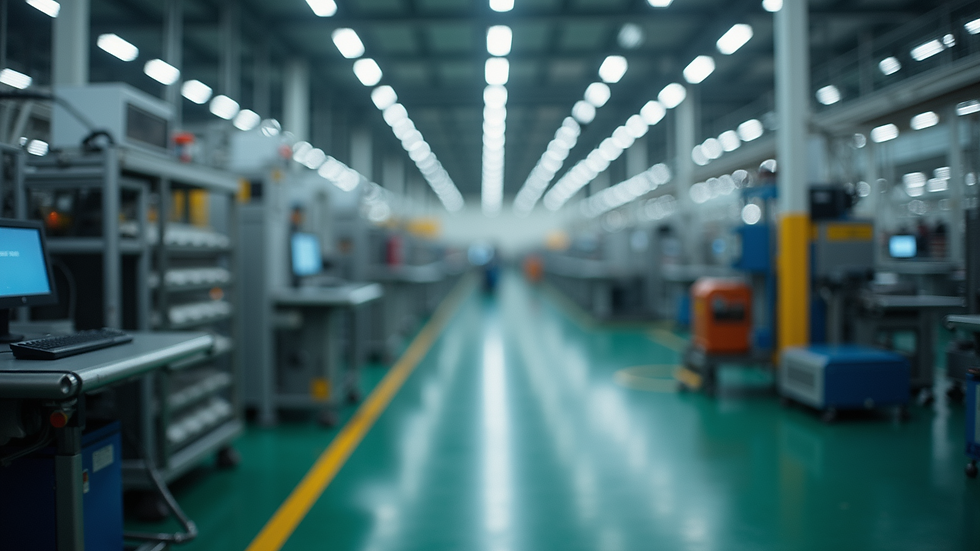Streamlining Operations with Advanced Material Handling Solutions
- Ryan Patrick Murray
- Jul 28
- 4 min read
In today's fast-paced business environment, optimizing operations is more critical than ever. Efficient material handling is key to maximizing productivity, reducing costs, and ensuring the satisfaction of your customers. Many industries, from manufacturing to logistics, rely on streamlined processes that enhance workflow and minimize errors. Advanced material handling solutions can provide a strong backbone for achieving these goals, enabling businesses to operate more smoothly and efficiently.

Understanding Efficient Material Handling
Efficient material handling involves the movement, protection, and control of materials throughout the manufacturing, warehousing, distribution, consumption, and disposal stages. The goal is to facilitate the safe and effective flow of goods while reducing handling costs and improving operational safety.
Incorporating advanced technologies into material handling processes has shown significant benefits. For instance, automatic guided vehicles (AGVs) and robotics can reduce labor costs and improve accuracy in inventory management. According to a study by the Warehousing Education and Research Council, companies that employ automation in their material handling processes experience a productivity boost of about 30%.
Benefits of Advanced Material Handling Solutions
Implementing advanced material handling solutions can significantly improve operational efficiency. Here are some of the main benefits:
Increased Efficiency: By utilizing automation, businesses can streamline repetitive tasks. Tasks that once required extensive labor can be completed more quickly and accurately with machines. This shift not only saves time but also reallocates human resources to more value-added activities.
Improved Safety: Safety is paramount in any operational setting. Automated systems reduce human error, minimizing the risk of accidents. For example, employing conveyor systems and robotics reduces the need for employees to lift heavy materials repeatedly, decreasing the chances of injury.
Enhanced Inventory Management: With technologies like RFID tracking and automated inventory systems, businesses can keep better track of their stock levels. This ensures that you always know what is available, helping you to avoid overstocking or stockouts.
Cost Reduction: While there may be initial costs associated with implementing advanced systems, the long-term savings can be substantial. Reduced labor costs, fewer errors, and minimized product damage all contribute to lower overall operational costs.

Choosing the Right Material Handling Equipment
Selecting the right equipment is crucial to reaping the benefits of efficient material handling. Here are some factors to consider:
Assess Your Needs: Conduct a thorough assessment of your current material handling processes. Identify bottlenecks and areas for improvement. This will inform your decision on what equipment will be the most beneficial.
Consider Flexibility: The right handling solution should be adaptable to changing business needs. Equipment such as modular conveyors can be reconfigured to accommodate different workflows.
Evaluate Technology Options: From automated storage and retrieval systems (AS/RS) to conveyor belts, there are numerous options available. Look for systems that integrate seamlessly with your existing operations and offer scalability for future growth.
Invest in Training: Implementing new systems can be challenging. Ensure that your employees receive adequate training to utilize the new equipment effectively. This investment will pay off by minimizing the learning curve and reducing downtime.
Real-World Applications of Efficient Material Handling
Several industries have effectively implemented advanced material handling solutions, showcasing the diverse applications available.
For example, in the automotive industry, automated guided vehicles are used to transport parts across the manufacturing floor. These AGVs improve accuracy in parts delivery, reducing downtime in production lines. Similarly, in the retail sector, fulfillment centers are utilizing robotics to pick and pack products efficiently, significantly speeding up the order fulfillment process.
Another noteworthy application can be found in pharmaceuticals, where precise handling and tracking of products are essential for compliance. Advanced material handling solutions ensure that medications are moved securely and accurately throughout the distribution chain.

Future Trends in Material Handling
The landscape of material handling is always evolving. Here are some trends that are shaping the future of this industry:
Artificial Intelligence: AI is becoming increasingly integrated into material handling systems. From predictive analytics that forecast demand to machine learning algorithms that optimize logistics, businesses can leverage AI to make data-driven decisions.
Sustainability: As more companies prioritize sustainability, environmentally-friendly material handling solutions are on the rise. This includes using energy-efficient equipment and optimizing routes to reduce emissions.
Collaboration Between Human and Machine: The future of material handling will likely see an increased emphasis on collaboration between humans and machines. This hybrid approach leverages the strengths of both entities to enhance efficiency and safety in operations.
IoT Integration: The Internet of Things (IoT) will play a significant role in the future of material handling. By connecting machines and equipment through IoT devices, businesses can gain real-time insights into their operations, enabling smarter decision-making.
Embracing Change for Improvement
In conclusion, efficiently managing materials is crucial for any business looking to stay competitive. Embracing advanced material handling solutions can lead to significant improvements in efficiency, safety, and overall operational costs. The benefits of adopting such technologies far outweigh the initial investment, paving the way for a more streamlined and productive future.
By evaluating your current processes, investing in the right equipment, and staying informed on industry trends, you can enhance your operations and better meet the demands of the modern marketplace. The potential for improved performance is immense, and those who take the initiative to optimize their material handling solutions will undoubtedly lead the way towards greater success.


